Personal Income: It's All Relative
The Bureau of Economic Analysis has released personal income data for the 50 states and the District of Columbia through the last quarter of 2007. Although the fourth quarter of 2007 (2007:4) data are preliminary, earlier quarters of recent years have been revised. This updates our view of how the United States and Indiana economies have been performing.
Changes in personal income are a closely watched indicator of economic health. As with many economic measures, how changes are viewed depends on one's point of reference. This is especially true when assessing personal income at the state level over time. This article examines changes in quarterly personal income for Indiana relative to the United States over four decades.
In 2007:4, the U.S. economy, as measured by personal income, barely managed to grow after adjustment for price changes.1 After achieving an annualized real growth of 3.6 percent in 2007:3, the economy slowed to a negligible 0.1 percent annualized growth rate in 2007:4. From the fourth quarter a year earlier, U.S. real personal income grew by 2.4 percent.
Indiana was among 21 states2 to have a decline in real personal income in 2007:4. With an annualized rate of -0.4 percent, Indiana ranked 42nd in growth that quarter among the states. For the year (2006:4 to 2007:4), Indiana realized real growth of 1.4 percent, ranking 46th among the states.
To put Indiana's results in historical context, despite the slight 2007:4 downturn, this was the second highest quarterly personal income figure ($181.6 billion) in the state's history. This reflects a generally upward trend in personal income growth over time. The state's income growth, however, has not been as strong as the nation's for many decades. Since 2000:1, Indiana has lagged the nation in 20 of 32 quarters (see Figure 1).
Figure 1: Quarterly Difference Between Indiana and U.S. Personal Income Growth Rates, 2000 to 2007
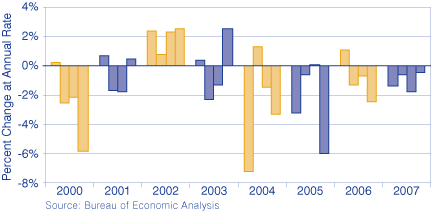
Over the 40 years from 1968, the nation enjoyed 137 quarters of real growth and only 23 of decline. Indiana had 120 positive quarters out of the 160 quarters in that 40-year period. During that era, Indiana lagged the nation's rate in 96 quarters and exceeded the country's rate in 64 quarters. Thus, 60 percent of the time, Indiana was growing, but more slowly than did the nation (see Figure 2).
Figure 2: Quarters with Positive and Negative Change in Personal Income, 1968 to 2007
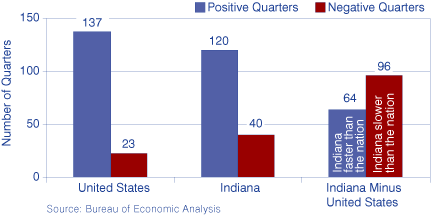
When examined by decade, the period 1978 to 1987 was Indiana's worst relative to the nation (see Figure 3). In this long-term view of personal income growth, quarterly from 1968 to 2007, Indiana had an average annual growth rate of 2.6 percent compared to the national average of 3.3 percent.3 However, Indiana has out-performed neighboring Illinois (2.4 percent), Michigan (2.2 percent) and Ohio (2.1 percent). As seen in Figure 4, the nation was led by Nevada (6.5 percent) followed by Arizona, Florida and North Dakota (all above 5 percent).
Figure 3: Difference Between Indiana and U.S. Personal Income Growth Rates
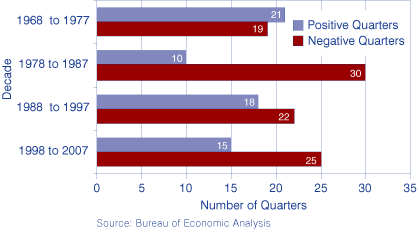
Figure 4: Average Percent Change in Quarterly Personal Income, 1968 to 2007
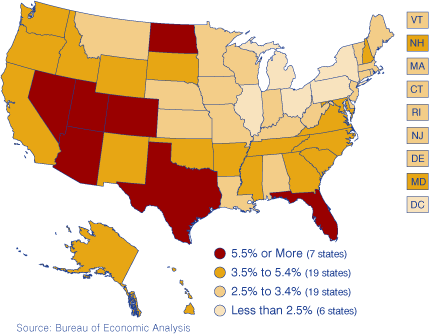
Growth rates are important, but of equal interest is the volatility of change. Some states may have low rates of growth, but remain fairly consistent, varying little from the average. Other states may have similar low rates of growth, but experience wide swings from periods of rapid growth to other periods of extremely slow growth.
For our purposes, volatility is measured by the coefficient of variation (C.V.)4 in the annualized quarterly growth rates of personal income. Indiana was 12th in the nation in volatility. Michigan ranked seventh and Ohio 14th. The faster growing states of Nevada, Florida, Arizona and Texas were the least volatile5 (see Figure 5).
Figure 5: Rank in Personal Income Volatility, 2007
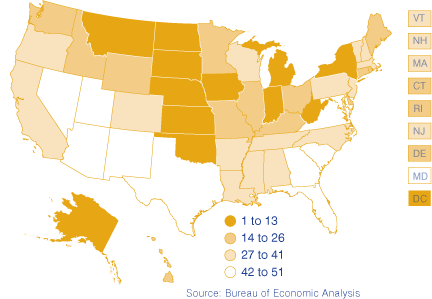
Summary
The latest personal income data reveal that Indiana's personal income continues to grow, but like its neighboring states, that growth continues to lag the nation's growth rate. At the same time, Indiana has a high level of volatility in personal income growth rates, which can make planning in the public and private sectors more difficult.
Personal income data are available on STATS Indiana's States in Profile (www.stats.indiana.edu) and also in the income tables, with historical data and inflation-adjusted figures available. For more detailed information on how personal income data are collected, visit the U.S. Bureau of Economic Analysis website at www.bea.gov.
Notes
- The original data released by BEA has been adjusted by the quarterly values of the Personal Consumption Deflator. Hence, all references to percent changes in this article are in real (inflation-adjusted) terms.
- All rankings and counts of states include the District of Columbia.
- Data for Louisiana and Mississippi exclude 2005:3 through 2006:1 because of the hurricanes that ripped through those states and gave them extraordinary rates of decline and growth.
- The coefficient of variation compares the variation in a set of values to the set's mean, and is equal to the standard deviation divided by the mean. It approaches infinity as the mean goes to zero. A C.V. of 0 would mean no variation in the series of growth rates. A value of 1 for the C.V. indicates that the standard deviation of the series is equal to the mean (as a point of reference); higher values indicate still greater volatility.
- Although there is an inverse relationship between the growth rate and the C.V., it is not statistically significant.
Morton J. Marcus, Director Emeritus
Indiana Business Research Center, Kelley School of Business, Indiana University
